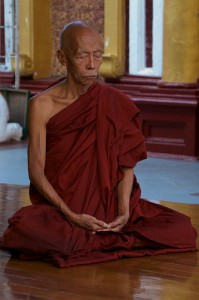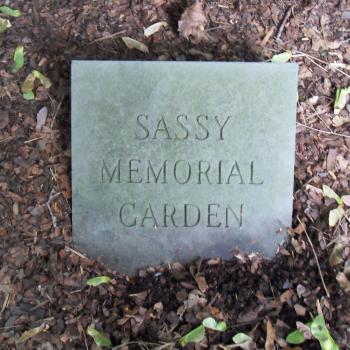 Yesterday I traced the spirituality of a Zen Garden stroll, then of meditation based on the ancient Eastern insight that, as the Upanishads says:
Yesterday I traced the spirituality of a Zen Garden stroll, then of meditation based on the ancient Eastern insight that, as the Upanishads says:
This whole universe is Brahman… He who consists of mind, whose body is the breath of life… He is my Self within the heart, smaller than a grain of rice or a barley-corn… greater than the earth.
Mysticism is the general name for this insight: that, in a nutshell (or a barley-corn), God “is my Self within the heart.” All major religions have their mysticisms, because all have believers who’ve experienced the transcendent God within their hearts. Islam has Sufis. Christianity has monastic life, with meditation its core practice: the discipline of disposing oneself for direct experience of the divine. Often called “contemplative prayer,” it’s widely practiced by ordinary Christians as well.
Though contemplation, meditation, and mysticism aren’t always interchangeable, they can be for my purpose here. All religions are definitely not interchangeable, but they all share the mystical spiritual experience. This is logical, since there’s only one God; and direct experience of God would be as unmediated as an experience can be.
When mystics describe their experience, it’s mediated by the concepts of their particular religion. But common images recur.
Especially the mirror. “Man was made in order that in his emptiness and purity of heart he might mirror the purity and freedom of God and thus be perfectly one with Him” (Thomas Merton). This is also what an ancient Sufi heard when asking God why we’re made: “The wisdom of My creating you is to see My vision in the mirror of your spirit, and My love in your heart.” And in Satori (Zen Enlightenment), “the mirror of mind… seems so thoroughly swept clear as not to leave a particle of dust on it” (scholar D. T. Suzuki).
Dusting clean the mirror of mind or heart is lifelong work, all religions agree. You don’t just grab a rag and—behold! all is clear. Before the mirror can “reflect the primordial divine light,” writes a scholar of Sufism, “it must be polished by constant asceticism until all dust and rust have disappeared.”
Asceticism, self-surrender, and renunciation are mysticism’s musts. A daily grind on hands and knees, scrubbing at the soul’s grit, soaking the rag with repentant tears, dying with Christ, struggling toward Nirvana: getting to see the inner light is no picnic. It’s a pain (though a labor of love). Ego dies hard. But when the dust does clear, the soul and God (says a Sufi poet) reflect one another like mirrors, two lovers contemplating each other’s gaze. “When,” a Zen master confirms, “you surrender all that belongs to your inmost self, you gain peace.”
I’m personally not good at self-surrender. But for years I’ve been trying: practicing a daily meditation that draws on Buddhism, the Gita, and Christian contemplative prayer. I practice. It’s a clumsy, distracted practice. My inner mirror has never been swept clear; I’ve had no dazzling mystic vision. I’ve rarely, during these attempted contemplative times, even felt inner peace.
But once, as a result of these daily attempts, I was able to convey an inner peace I didn’t feel—and hence keep from doing someone harm. It was the November morning my furnace wouldn’t start—for the sixth day in a row.
Bundled in blankets, I’d been waiting each day for the promised repairman. He finally came on Day Five, banged in the basement, then pronounced the furnace “Fixed!” But on Day Six, when I woke and turned up the thermostat, the furnace balked.
Argh! As the house temperature dropped, my emotional temperature rose. Blood boiling, heart racing with rage, every exasperation cliché fit my mood. Another day’s plans ruined; another day’s work lost.
During the hour’s wait before the repair office would open so I could call, I was too full of agitated lines to achieve anything like an “emptying” state. At such times, I’d learned over the years, the only hope is to drown out the inner racket with words from another realm. I grabbed my current meditation text from the fifteenth-century spiritual classic, The Imitation of Christ:
All our peace, while we be in this mortal life, standest more in meek suffering of troubles, and of things that be contrarious unto us, than in not feeling them: for no man may live here without some trouble. Therefore, he that can best suffer shall have most peace.
I wasn’t dignifying this furnace nuisance as a huge trouble. But it was contrarious unto me, for sure. Repeating this passage for an hour like a mantra, I heard it saying that, paradoxically, this trivial trouble might be a gift—if I got through it meekly. “Meek suffering” I understood as Buddhist self-surrender: feeling the natural irritation while also foregoing it; foregoing, that is, the instinct to force it on someone else.
Raging at the repair department’s receptionist would be forcing her to deal with it—which seemed both violent and unfair. Just because my day had begun contrarily, should hers have to? Whose day is this, anyway (I heard Buddhism asking)? What makes me claim it as “mine”? This day the Lord has made, sings the Hebrew psalmist. This whole universe is Brahman, and He is my Self within the heart, the Self in whom (Christ and Krishna declare) peace subsists.
Let that Self speak to the receptionist instead of this infuriated one, I prayed as I dialed.
The prayer was answered. “You sound cheerful,” she said, when I’d told my tale of woe.
Hanging up, I sat transfixed. It seemed as if—for that instant speaking to her—I’d touched base with transcendence. Though I’d felt agonizingly unpeaceful, a peace more inner and more outer than mere feelings had spoken through my voice. So a person had been spared violence.
I was as grateful as if I’d been about to stab her, and an angel had stayed my hand.
Peggy Rosenthal is director of Poetry Retreats and writes widely on poetry as a spiritual resource. Her books include Praying through Poetry: Hope for Violent Times (Franciscan Media), and The Poets’ Jesus (Oxford). See Amazon for full list. She also teaches an online course, “Poetry as a Spiritual Practice,” through Image’s Glen Online program.














